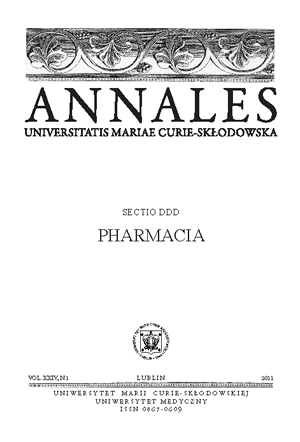Porównanie analizy ilościowej glikozydów flawonoidowych wyizolowanych z kwiatostanów Sambucus nigra L. metodą Chromatografii Cienkowarstwowej oraz Wysokosprawnej Chromatografii Cieczowej.
Słowa kluczowe:
Metody ekstrakcyjne, flawonoidy, Sambucus nigra L., HPLC, TLCAbstrakt
Flawonoidy są związkami, które posiadają ważne działanie farmakologiczne (anty-oksydacyjne, anty-zakrzepowe, hipotensyjne, przeciwzapalne). W związku z tym istnieje konieczność opracowania odpowiedniej metody izolacji i analizy tych substancji w materiale roślinnym. Celem pracy było porównanie analizy ilościowej TLC i HPLC wybranych glikozydów flawonoidowych (rutyna i isoquercetrin) z kwiatostanu bzu czarnego Sambucus nigra L. (Caprifoliaceae). Próbki zostały przygotowane przez ekstrakcję materiału roślinnego z metanolem lub 80% metanolem w wodzie. Zastosowano następujące metody ekstrakcyjne: ekstrakcja w aparacie Soxhleta, ekstrakcja wspomagana (MASE), ekstrakcja z wymuszonym przepływem rozpuszczalnika (ASE) i ekstrakcja wspomagana ultradźwiękami (USAE). Próbki zawierające flawonoidy oczyszczono metodą SPE C18 i analizowano metodą HPLC. Jednocześnie wykonano analizę ilościową rutyna i izokwercytryny metodą TLC.
W eksperymencie wykazano podobną skuteczność obu metod analizy ilościowej
Bibliografia
1. Albu S. et al.: Potential for the use of ultrasound in the extraction of antioxidants from Rosmarinus officinalis for the food and pharmaceutical industry. Ultrasonics Sonochem., 11, 261, 2004.
2. Benthin B., Danz H., Hamburger M.: Pressurised liquid extraction of medicinal plants. J. Chromatogr. A, 837, 211, 1999
3. Dajas F. et al.: Neuroprotection by flavonoids. Braz. J. Med. Biol. Res., 36, 1613, 2003.
4. Folts J.D.: Potential health benefits from the flavonoids in grape products on vascular disease. Adv. Exp. Med. Biol., 505, 95, 2002.
5. Garcia-Ayuso L.E., Luque de Castro M.D.: Employing focused microwaves to counteract coventional Soxhlet extraction drawbacks. Trends in Anal. Chem., 20, 28, 2001.
6. Giannuzzo A.N. et al.: Supercritical fluid extraction of naringin from the peel of Citrus paradisi. Phytochem. Anal., 14, 221, 2003.
7. Hong N. et al.: Microwave-assisted extraction of phenolic compounds from grape seed. Nat. Prod. Lett., 15, 197, 2001.
8. Huang J., Zhang Z.: Microwave-assisted extraction of quercetin and acid degradation of its glycosides in Psidium guajava leaves. Anal. Sci., 20, 395, 2004.
9. Kaufmann B., Christen P.: Recent extraction techniques for natural products: microwave-assisted extraction and pressurised solvent extraction. Phytochem Anal.,13, 105, 2002.
10. Kohlmünzer S.: Farmakognozja. PZWL, Warszawa 1993.
11. Li H., Chen B., Yao S.: Application of ultrasonic technique for extracting chlorogenic acid from Eucommia ulmodies Oliv. Ultrasonics Sonochem., 12, 265, 2005.
12. Luque de Castro M.D., Garcia – Ayuso L.E.: Soxhlet extraction of solid materials: an outdated technique with a promising innovative future. Analytica Chimica Acta, 369,
1, 1998.
13. Lyseng-Williamson K.A., Perry C.M.: Micronised purified flavonoid fraction: a review of its use in chronic venous insufficiency, venous ulcers and haemorrhoids. Drugs, 63, 71, 2003.
14. Robak J., Gryglewski R.J.: Bioactivity of flawonoids. Pol. J. Pharmacol., 48,
555, 1996.
15. Scalia S., Giuffreda L., Pallado P.: Analytical and preparative supercritical fluid extraction of chamomile flowers and its comparison with conventional methods. Mass. Spectrom., 18, 211, 2004.
16. Snyder L.R, Kirkland J.J, Glajch J.L.: Practical HPLC method development. John Wiley & Sons, INC. New York 1997.
17. Waksmundzka-Hajnos M. et al.: Effect of extraction method on the yield of furanocoumarins from fruits of Archangelica officinalis Hoffm. Phytochem. Anal., 15, 313, 2004.
18. Waksmundzka-Hajnos M. et al.: Influence of the extraction mode on the yield of some furanocoumarins from Pastinaca sativa fruits. J. Chromatogr. B, 800, 181, 2004.
19. Waksmundzka-Hajnos M. et al.: Effect of sample preparation methods on the quantitation of selected flavonoids in plant materials by high performance liquid chromatography, Acta Chromatogr., 20, 475, 2008.
20. Zgórka G.: Retrntion behavior of silica-bonded and novel polymeric reversed-phase sorbents in studies on flavones as chemotaxonomic markers of Scutellaria L.genus. J. Chromatogr. A, 1120, 230, 2006.
Pobrania
Opublikowane
Numer
Dział
Licencja
Prawa autorskie (c) 2011 Autorzy

Praca jest udostępniana na licencji Creative Commons Attribution-NonCommercial-NoDerivatives 3.0 Unported License.


